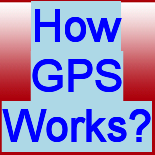How GPS Works?
Introduction
GPS or Global Positioning System is a technology for locating a person or an object in three dimensional space anywhere on the Earth or in the surrounding orbit. GPS is a very important invention of our time on account of the many different possibilities it brings. The technology is still involving and new applications are being developed to make full use of its potential.
The Idea behind GPS
The GPS system works with the help of a satellite network. Each of these satellites broadcasts a specific signal quite like a normal radio signal. These signals that carry the location data are received by a low cost aerial which is then decoded by the GPS software.
The software is able to identify the satellite, its location in space and the time the signals take to travel from each satellite. The software then processes the information it receives from each satellite to calculate the position of the receiver. The overall process is quite like traditional navigation methods. If you can draw lines from three predefined places on the map to where you are, you can identify your position on map as the intersection of these lines, within a margin of error.
Error Rectification
As we saw earlier, there are a number of factors that prevent absolute accuracy in locating the receiver. One major reason is that it is impossible to achieve perfect synchrony between the clocks in all the satellites and the GPS receiver.
The satellites have atomic clocks which are very accurate by themselves and with respect to each other. But it is not possible to fit the GPS units with atomic clocks as atomic clocks are very expensive, and this is what usually causes time errors.
However the GPS system has been designed to account for any error element due to the time factor. A fourth satellite is brought into the picture for cross checking the process. This enables the software to rectify not only any discrepancy in the calculations, but also any inaccuracy of its own clock.
GPS and Mapping
GPS by itself helps us only to know where the device is in space. However this has to be combined with mapping for many of the practical applications of GPS. The mapping part enables the user to work out possible routes and plan trips in advance. It is often this mapping component that adds to the price of a GPS package. The mapping data has to be accurate and be updated often.
There are different kinds of maps for different users and kinds of needs. For instance, road users need maps that give accurate information about the road network in the region where they travel. However their maps need not contain information such as the height of hills. On the other hand people who use GPS for hiking need a detailed map of the terrain with rivers, hills, tracks and trails. Similarly what marine users need is information about sea bed, navigation channels and such maritime data.
GPS is also used for fishing purposes like tracking shoals of fish and predicting their movements. This has huge benefits for cooperative fishing. The several boats in a group can relay their location and information about where they find the best fishing waters. There are special GPS packages called fish-finders for this purpose. Fish-finders have additional features like sonars, advanced tracking functions as well as data storage capacities.
An Overview of Consumer GPS Devices
The consumer range of GPS solutions start with sophisticated car GPS systems- they can have features like voice guiding, dynamic route calculation and in built features to load and update a map from a CD.
The handheld range includes GPS devices from companies such as Magellan and Garmin. These typically have maps stored inside and work well for outdoor use. However the handheld range does not usually have dynamic route calculation facility and so the user has to find his/her route.
Another application that was launched in the market recently has GPS working in a PDA. The PDA is designed to connect with a GPS receiver. This range is generally cheap, but the PDA based application is not very rugged. There are also variants that use wireless Bluetooth connections. These can work both for personal navigation as well as inside a vehicle.



